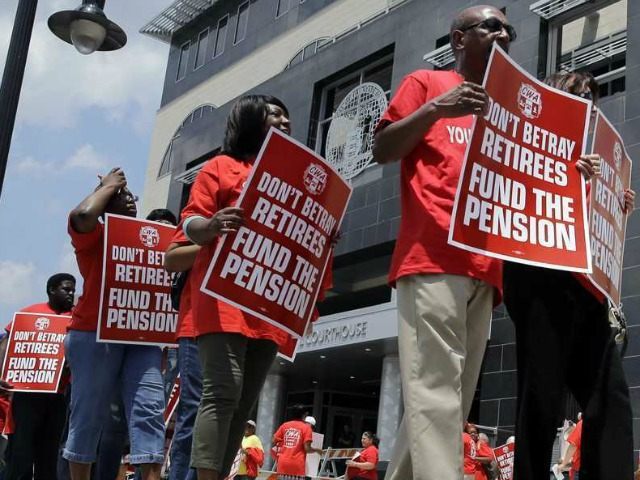The 100 largest public employee pension plans in the United States face an unfunded liability of more than $1 trillion. This figure, compiled by consulting firm Millman, likely underreports the actual liability, because it is based on the plans’ own, rather rosy, assumptions of investment returns.
The true gap between what politicians have promised state and local government employees and the resources currently available to meet the promises is several hundred billion more dollars, around $1.2-1.3 trillion.
Keep in mind, this is the unfunded liability for just the 100 largest public sector plans. The total deficit for all public sector pension plans in the country is far higher. It is also important to bear in mind that this deficit is likely to explode in the coming years. The average rate of return built into the pension plans is currently 7.65 percent annual growth. Even the best managed plans will be hard pressed to earn that kind of investment return in the year ahead.
Fiscally, this pension deficit jeopardizes taxpayers and almost all other state and local budget items. The amount states have allocated to their pension systems has almost doubled in the past decade, but even that higher spending hasn’t made a dent in the unfunded liability owed. The number of retired and inactive members now outnumbers active members in the public sector pensions.
This represents something of an inflection point for public pensions, since active members are at least contributing a portion of their pay, albeit small, to the pension plan. Retired and inactive members are simply drains on the pension plans’ resources.
While the situation is a challenge for taxpayers, its a political disaster for Democrats. The symbiotic relationship between Democrats and public sector unions is far more pronounced at the state and local level than even at the federal level. In most states, public sector unions are the largest campaign donors and exert a massive lobbying presence. It is extraordinarily difficult for a Democrat politician to be elected at the state and local level without the explicit support of public sector unions.
Since 2009, however, a number of Democrat governors have been forced to trim pension benefits. California and Minnesota have raised employee contributions to pension plans. West Virginia has raised employee contributions for new hires.
In Pennsylvania, one of two states currently operating without a budget, new Democrat Gov. Tom Wolf has agreed to pension cuts for new and current state employees in exchange for breaking a budget impasse with the Republican legislature.
“I know you’re not going to be happy,” Mr. Wolf told union leaders in private phone calls to union officials during recent weeks, the Wall Street Journal reported.
On Tuesday, Wolf backed off this agreement as public school teachers threatened to strike and close schools. Wolf’s office says he still wants to include pension cuts in a larger budget agreement.
“If it’s a Democrat undermining our members, they’ll feel the heat as much as if they were a Republican,” Steven Kreisberg, senior staff with AfSCME, the American Federation of State, County and Municipal Employees, told the Journal.
Pennsylvania, like many states, has a math problem. Its unfunded pension liability is over $50 billion. This puts the state on par with California, which has a $174 billion liability. In both states, only around 70 percent of the pension liability is funded.
These two states are paragons of fiscal prudence, however, compared to Illinois. The pension funds in that state, which has long been dominated by Democrats, are only 30-40 percent funded. The funding gaps in Pennsylvania and California would be double their current levels if they had been managed as poorly as Illinois.
Illinois, like Pennsylvania, is without a state budget as a Republican Governor is in a spending stand-off with an overwhelmingly Democrat legislature. The impasse, however, is not over the woefully underfunded pension system. The state Supreme Court, an elected body, recently overturned a pension reform plan as unconstitutional.
Whether Illinois ends its current budget stalemate is almost beside the point. Fiscally, the state is doomed unless it finds a solution to its pension nightmare.
Illinois is somewhat unique, in that its underfunded pension problem is an order of magnitude worse than most other states. Almost every state, however, faces stark choices in the years ahead. Choices that could become much harder if there is another economic downturn.
State and local governments cannot honor the promises they made to public sector employees, unless they hike taxes on citizens higher than politically feasible. Democrat politicians face a nightmare scenario in the coming years. They will have to explicitly choose between taxpayers and union members.
Again, this isn’t a prediction. It’s math.

COMMENTS
Please let us know if you're having issues with commenting.